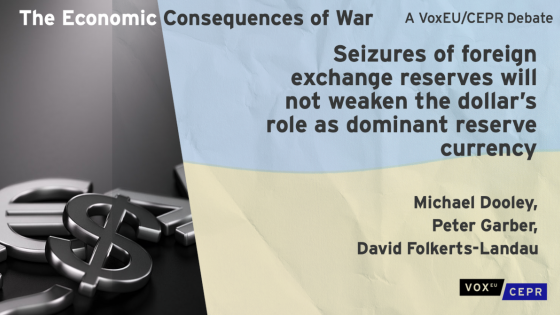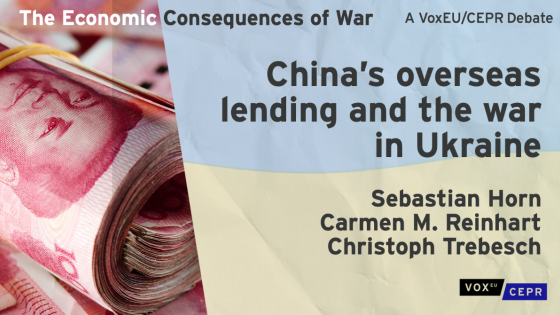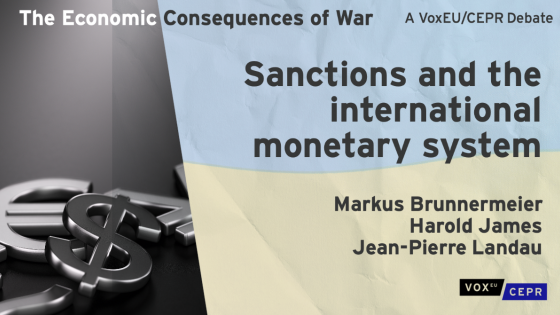Editors' note: This column is part of the Vox debate on the economic consequences of war.
Sanctions imposed by the US on Russia have generated a lively debate about the ability of the dollar to maintain its position as the dominant reserve currency.1 The surprisingly strong sanctions limiting the use of Russian dollar reserves suggests that, at least for some countries, accumulation of dollar assets for a rainy day will be less attractive. But the consensus view seems to be that the dollar will remain dominant if only because there is no good alternative (Brunnermeier et al. 2022).
The current debate is driven by the assumption that governments hold reserves to smooth international payments in the face of trade or capital account disturbances. We have no quarrel with this line of thought, but have argued since 2003 that it provides a seriously incomplete framework for understanding the modern role of the dollar and the US in the international monetary system (Dooley et al. 2008).2 Empirical research suggests that the traditional story is incomplete in the face of very large reserve accumulations by China and other emerging markets since 2002 (Levy Yeyati 2010, Calvo et al. 2012). Rather than stretching the traditional story to fit the facts, we propose an additional reason for holding reserves. In our framework, optimal reserve holdings for poor countries seriously pursuing economic development should be much larger than amounts suggested by the conventional model. Moreover, there are good reasons for the US and the dollar to continue to play the dominant role in the system, notwithstanding a record of previous freezes or even expropriations of reserves.
In our framework, the willingness and ability to engage in comprehensive financial asset seizures is part of the job description for a modern reserve currency. Such potential seizures were the collateral foundation of the massive expansion of net and gross capital flows between rich and poor countries for at least the past 25 years. Moreover, for good reasons, the US was and is the country most trusted and most likely to fulfil this responsibility. It has had a long track record of seizing foreign assets while suffering no diminution of its role as the key reserve currency.3 It follows that the demonstration that the US and its allies are willing to impose sanctions even against a militarily powerful country reinforces the dollar’s dominance going forward.
The most important historical example of demand for reserves to reassure private foreign investors is that of China after 2002. China had to convince foreign industrial capital that the Chinese government, hitherto a fervent enemy of private capital, would not ultimately expropriate their investments. China’s policy employed to manage the exchange rate, i.e. sterilised foreign exchange intervention, also provided the reserve accumulation commitment necessary to support the inflow of private foreign capital. The accumulation of collateral may have been inadvertent, but this made it no less effective.
This net export of Chinese capital for collateral has been so large and permanent that long-term real interest rates in industrial centre countries have been reduced for the last 20 years. An influential academic theory for persistently depressed real interest rates in the centre is that the US supplies ‘safe assets’ to the rest of the world (Caballero et al. 2017). This is only part of the story. The US also produces assets that are unsafe to those who misbehave, and these also are in high demand. The centre country must provide safety for good behaviour and punishment for bad behaviour.
A key difference between a transaction demand for reserves and the collateral demand for reserves is that collateral demand is much larger. The collateral that was provided by reserve accumulation was comparable in China to what would have been required between private investors with comparably different credit risks. We calculated the collateral requirement for a hypothetical total return swap of reserves against direct investment. To our surprise, direct investors in China were getting about what a commercial swap would require. Over the years, updates in our calculations reconfirmed our findings (Dooley et al. 2014).
The analogy with private collateral arrangements is useful but should not be taken literally. Private collateral is a powerful incentive for private lending to risky agents because it is both a deterrent to default and an almost risk-free guarantee of payment to the creditor. Moreover, the circumstances under which the collateral is forfeited are well-defined and enforced by the legal system where the credit contract is negotiated. Public collateral, in the form of international reserves, is also a powerful deterrent to default, but it is much less clear that all or any individual private international investors will be compensated. Notice, however, that by raising the cost of misbehaviour, the threat of US sanctions benefits all private investors in the risky country, not just US-based private investors.
What has changed?
In the past few months, an amazing array of Russian private sector assets – from banks to boats – have proven to be vulnerable to seizures by centre country governments. These include financial and even real assets held by the Russian government, government officials, and powerful and super-wealthy private sector allies of the government. Moreover, blocking access to Western payments systems and insurance contracts makes many private assets of the periphery country vulnerable, even many of those in-country.
What is the reaction to this enormous de facto expansion of the stock of assets that comprise the public collateral pool of periphery countries? For risky country private persons with foreign assets, it will generate a shift to foreign assets that are less vulnerable and certainly less visible, although in previously uninviting places that are themselves quite risky.
But for governments of high political risk countries still participating in the dollar system the implications are less clear. Their existing stocks of foreign assets, suddenly so much more evidently vulnerable hostages given the revealed teeth of the US and its partners, will actually support more gross capital inflows from rich country investors now that any of their doubts of such enforcement have been dispelled. If the periphery government wants to encourage private foreign investment, building a stock of foreign reserves is now an even more powerful incentive for foreign capital.
Going forward, a key challenge for economic analysis is how the structure of a country’s gross foreign assets and liabilities will adjust to the new information about what is vulnerable to a counterparty’s official sanctions. The explosion of gross international capital flows in recent decades has been identified as an important source of world growth. The scale of collateralisation in these decades would not have been possible without the liberalisation of domestic financial systems and the associated expansion of gross international capital flows. The scale and composition of gross flows in themselves are far more important for development than the conventional academic analysis of net savings flows across countries. High risk countries that exit the dollar bloc will have very restricted ability to reassure foreign investors. The result will be exclusion from the growth strategy that involves participation of centre country capital.
A small part of this financial intermediation will be curtailed as Russia drops out of the system (Bekkers and Góes 2022). If China also exits, or more likely starts to prepare for an exit, this will be a far more important change in the international system (Horn et al. 2022). But if that exit is a hostile and sudden process, China will face the price of similar asset seizures to Russia. Our main conclusion, however, is that the dollar will remain the central reserve currency of the remaining dollar-based system and that the role of the dollar and the demand for dollars will increase within that bloc.
References
Bekkers, E and C Góes (2022), “The impact of geopolitical conflicts on trade, growth, and innovation: An illustrative simulation study”, VoxEU.org, 29 March.
Brettell, K (2022), “Analysis: As sanctions ‘weaponize’ U.S. dollar, some Treasury buyers could fall back”, Reuters, 29 March.
Brunnermeier, M K, H James and J-P Landau (2022), “Sanctions and the international monetary system”, VoxEU.org, 5 April.
Caballero, R J, E Farhi and P-O Gourinchas (2017), “The safe assets shortage conundrum”, Journal of Economic Perspectives 31(3): 29-46.
Calvo, G A, A Izquierdo and R Loo-Kung (2012), “Optimal holdings of international reserves: Self-insurance against sudden stop”, NBER working paper 18219.
Dooley, M, D Folkerts-Landau and P Garber (2008), “Asia, Interest Rates, and the Dollar”, Deutsche Bank Research.
Dooley, M P, D Folkerts-Landau and P M Garber (2014), “The revived Bretton Woods systems’s first decade”, NBER working paper 20454.
Eichengreen, B (2022), “Ukraine war accelerates the stealth erosion of dollar dominance”, FT.com, 28 March.
Horn, S, C Reinhart and C Trebesch (2022), “China’s overseas lending and the war in Ukraine”, VoxEU.org, 8 April.
Kessler, A (2022), “Is the Dollar in Danger?”, WSJ.com, 13 March.
Levy Yeyati (2010), “What drives reserve accumulation (and at what cost)?”, VoxEU.org, 30 September.
Loots, E (2022), “Russia sanctions: new impetus for Chinese yuan to mov up the reserve currency ladder?”, The Conversation, 22 March.
Pozar, Z (2022), “Bretton Woods III”, Credit Suisse, 7 March.
Wigglesworth, R, P Ivanova, C Smith (2022), “Financial warfare: will there be a backlash against the dollar?”, FT.com, 7 April.
Endnotes
1 For a small sample of opinions about how badly the dollar’s role will be hurt see Eichengreen (2022), Pozar (2022), Bretell (2022), Loots (2022), Kessler (2022), and Wigglesworth et al. (2022).
2 A compilation of this series can be downloaded here. In particular, we draw here from Chapters 1, 2, 3, 4, and 6, “An Essay on the Revived Bretton Woods System”, “The US Current Account Deficit and Economic Development: Collateral for a Total Return Swap”, “The Two Crises of International Macroeconomics”, “That Old Time Religion: It’s Good Enough for Me”, and “Direct investment, Rising Real Wages and the Absorption of Excess Labor in the Periphery”, respectively.
3 See Chapter 4 of Dooley et al. (2008), “That Old Time Religion: It’s Good Enough for Me”, pp. 68-69 for a history through 2005. The tempo of such seizures has become more intense since then.






